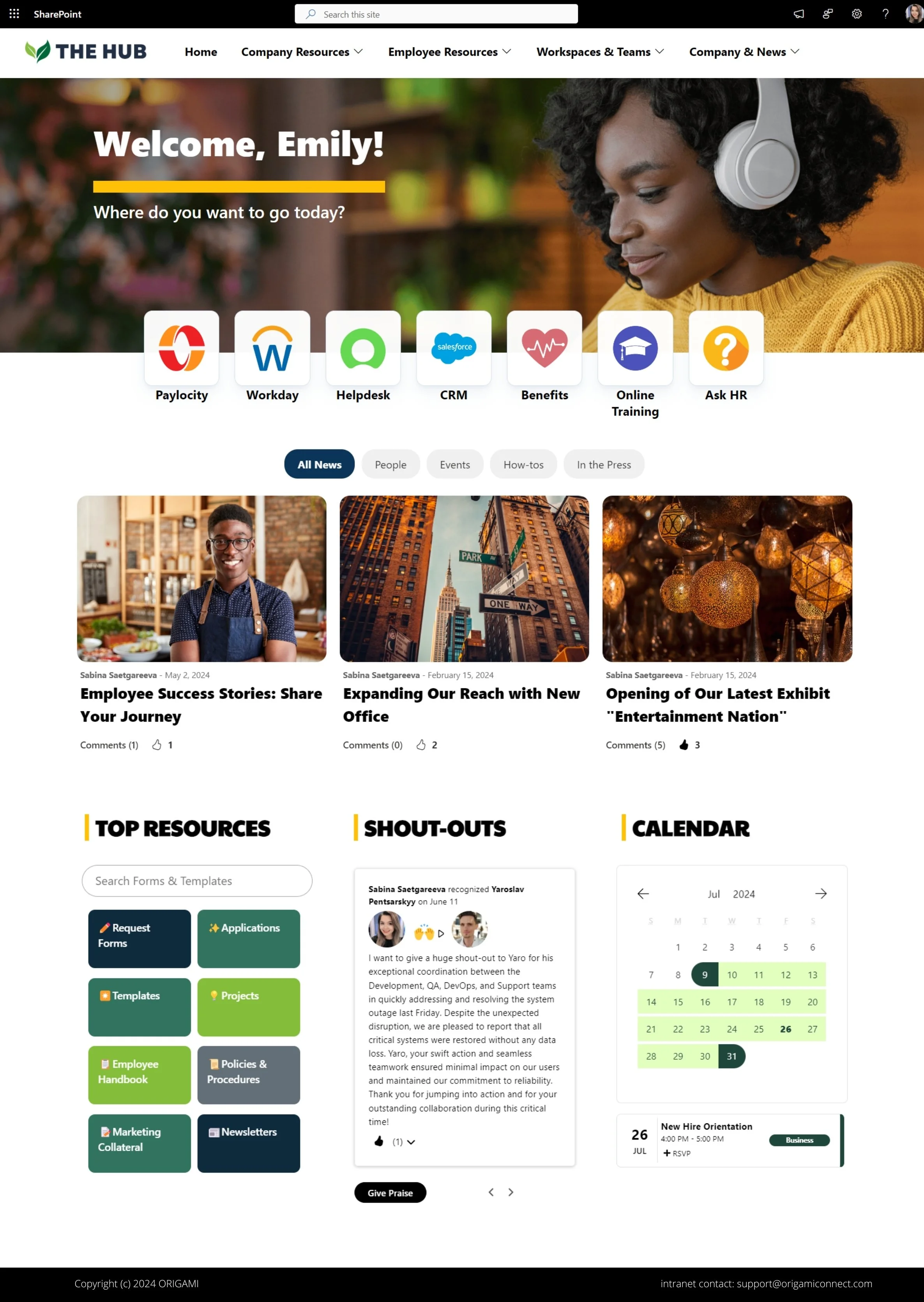Summary: Using a SharePoint Intranet for document management is the primary goal. As the organization grows, and various new or growing departments produce more content, a SharePoint Intranet can help you expand while building employee engagement. Here are some of the most common things that should live on your SharePoint Intranet.
Whether you already have an existing intranet primarily used for document management or starting a new one, relevant content is what your users are after. Some content is pretty obvious to put on the intranet, but not all of it. Here are 13 great candidates to go onto your SharePoint intranet:
#1: News & Email Newsletters
… I read that somewhere, now I can’t find it
Print newsletters circulating on the bulletin boards in the kitchen are still alive. Smaller organizations rapidly growing can take advantage of having wider visibility of this content when it’s on your intranet.
For organizations using email newsletters, it’s another great opportunity to move those to the intranet. As a benefit, you will get measurable results on how many people engage with your content and ultimately write more relevant content.
If you’re using an Intranet in-a-box, your product might already be coming with a variety of templates you can use to make your newsfeed look great without Photoshop.
#2 KPI’s
… How are we doing anyway?
Whether a public or private organization, you’re likely tracking KPI’s and communicating those goals to your employees. Those KPI’s are often hanging on the bulletin board or being disseminated via a “letter from executive“ email once every quarter or less.
By putting your KPI’s on the homepage or perhaps one of the sub pages, you will increase visibility, and simplify updating of the relevant targets.
#3 Memos and Corporate Communication
…oh, well, that’s good to know!
Corporate memos are important messages for everyone to know, so how do you ensure it gets to where it needs to?
Employees don’t typically seek out information in memos but if the headline sounds interesting or applicable they will read it.
To improve readability of memos, we encourage not to isolate them into their own container. Instead use your news web part to increase visibility so that more people are going to pay attention to it.
#4 Templates & Samples
…where is this PowerPoint when you need it?
One of the most common complaints about any intranet out there is that employees are not able to find Templates & Samples.
Most have to start their work by downloading existing content such as PowerPoint stripping it and using it as a template. Some of this content your staff may be downloading might be dated, with old logos and branding standards. Now you have a new document circulating created from the old sample.
Create a space for Templates & Samples where your staff can find Proposal Templates, Communications Templates, Letterhead etc. Keep those up to date in one place. If you have a new type of template, add it here. We see this area rapidly growing as organization adds more corporate collateral.
#5 Knowledgebase
… how do I reset my voicemail password?
Most of the organization’s knowledge is stored in … your employees heads.
Sometimes those employees document their process for their own convenience. Things like how-to’s and tips & tricks. By creating a repository for a knowledge-base, these know-hows have a place to live and others can use them.
#6 Outages
… wish I knew it before calling helpdesk and waiting for an hour
Outages, when they happen cause confusion and flood of emails and calls to IT. By putting critical and important outages on your intranet you can reduce the flood of calls.
We recommend critical outages to have a place right at the top of the home page for greater visibility. For detailed system outage information, you can use a web part under specific area of the site.
#7 Employee Feedback & Idea Crowd-sourcing
… How come no one has suggested this before?
Your employees work with specific process and tasks on a daily basis and, in many cases, have a great insight how a particular area of their work can be improved.
Employee feedback is the most powerful when other can see the suggested feedback and vote on it. It doesn’t mean you have to action all of the feedback but will give you a great visibility into what’s trending.
#8 Project Sites
…Where do I keep this project plan?
Some organizations deal with projects on a regular basis, such as consulting firms; others produce continuous work product and don’t have the concept of a project, even though ad-hoc project do take place.
Projects are different because of their cross functional nature. Several departments and vendors collaborate on the project and it doesn’t make sense to store all of that information under a particular site. Having a project site isolates the collaboration to the specific participants with respective permissions.
#9 Onboarding Materials
… Oh, yes, I forgot to order your business cards
All the forms and checklists, contacts, and training related to onboarding a new employee has to live somewhere. SharePoint intranet is a great place to have a dedicated area to this type of content. It’s much better choice than having printed binders which are hard to update and keep fresh.
#10 Offsite and Special Event Materials
…wish someone took a photo of that
We see some great materials coming from offsite events. Some organizations brainstorm future vision on a sketch-board and some even invite a professional sketcher to help them build those.
Employees feel inspired after those events and the materials produced in those events shouldn’t go to waste. Have an area for your offline corporate Events. You can also promote the area by featuring a news on the intranet related to the latest event.
#11 Policies and Procedures
…what are all the stat holidays we get?
First off, how is this different from the knowledge-base talked about earlier?
Policies are not how-to’s and tips & tricks. These are specific to larger organizations but not only. Those are typically HR, Finance, and other policies related to the business. Common information to go here are things like vacation request policies, contractor on-boarding policy etc.
#12 External Updates
…”it should be in the email with 3 attachments”
Investor Updates, related PDFs, External Partner Updates, and other externally focused and targeted communication often goes out as an email. If you need to attach a collateral such as a PDF document or a Fact Sheet to the email, use a SharePoint intranet as your repository. This will help you avoid bounced mailboxes and emails blocked by firewall or sent straight to spam.
Have a dedicated area for external communication and link to them in your communication. With SharePoint Online, you can allow guest link sharing which can expire in needed.
As a result, you will have access to all of the assets you sent over time and recipients’ mailboxes will be free of large attachments. It’s a win-win!
#13 Department Updates
…oh, the product team is growing?
News related to departments and areas of business are great candidates for a news app. The news app we use has dedicated sections for departments which allows your staff to still see the news item but it’s less prominent and leaves room for a main news item.
Conclusion
Your SharePoint intranet is a great place for corporate content which goes way beyond document management and collaboration. Whether you have an existing or building a new SharePoint intranet, increasing valuable content will boost your staff engagement. Content is King!
Help us grow this list! Send us some of your ideas!
Yaroslav Pentsarskyy is the Director of Product at Origami. He's also 8 time Microsoft MVP, speaker at many local and worldwide tech events, and a published author of several SharePoint related books.







See how we turned a default SharePoint homepage into a modern and stunning landing page.